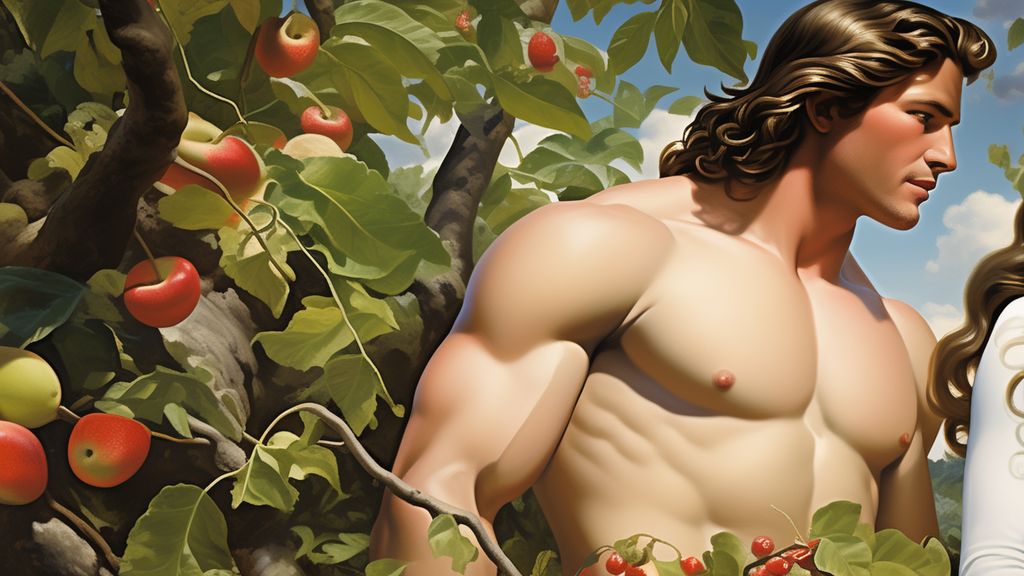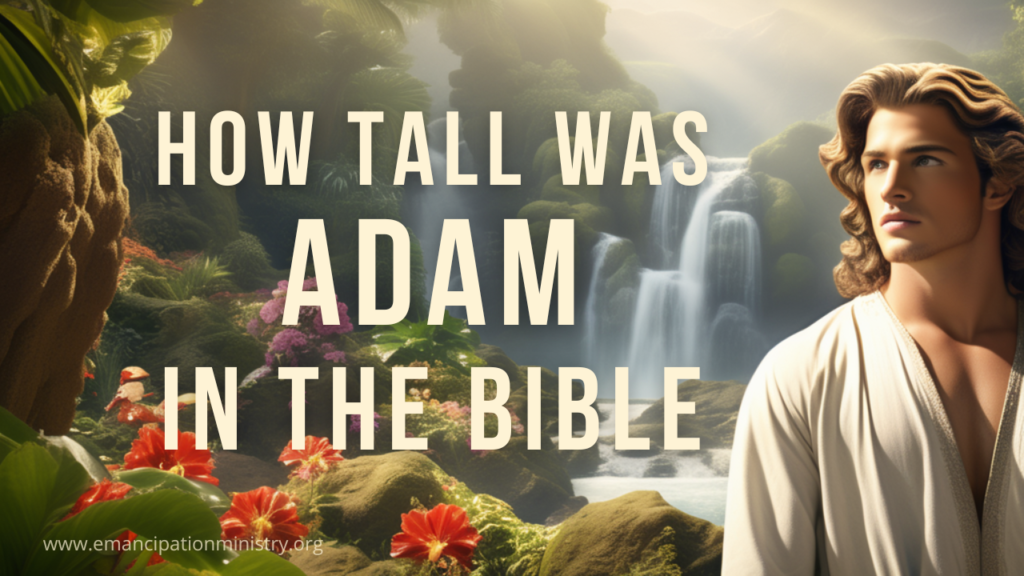Contents
- 1 How tall was Adam in the bible?
- 1.1 The Biblical Framework:
- 1.2 Clues and Considerations:
- 1.3 Historical Perspectives:
- 1.4 Theological Reflections:
- 1.5 Theological Reflections on Human Identity
- 1.6 The Dignity of Every Individual:
- 1.7 The Moral and Spiritual Essence:
- 1.8 Redemption and Restoration:
- 1.9 The Role of Community:
- 1.10 Human Responsibility and Stewardship:
- 1.11 Living out the Imago Dei:
- 1.12 Moral and spiritual growth:
- 1.13 Redemption: A Story of Hope
- 1.14 The communal dimension:
- 1.15 Stewardship and Responsibility:
- 2 Conclusion:
How tall was Adam in the bible?
Adam serves as the archetype of humanity’s genesis in the fabric of biblical stories. But the topic of Adam’s physical height has always fascinated academics and Christians alike. In this extensive blog article, we set out to solve the riddle of Adam’s height as it is described in the Bible. Come along as we examine several viewpoints, scriptural hints, and historical background to help us understand the significance of the first man.
The Biblical Framework:
We need to look to the scriptures—the primary source of knowledge on this key character in Judeo-Christian theology—to delve more into the question of Adam’s height. Chapters 1 and 2 of the Book of Genesis include the main account of Adam’s genesis.

According to Genesis 1:26-27 (NIV), “Then God said, ‘Let us make mankind in our image, in our likeness, so that they may rule over the fish in the sea and the birds in the sky, over the livestock and all the wild animals, and over all the creatures that move along the ground.'” Therefore, God made both males and females in his image, creating humans in his likeness.”
This foundational passage establishes the creation of humanity in the image and likeness of God. It serves as the prelude to the more detailed account of Adam’s formation in Genesis 2.
2. Genesis 2:7 (NIV): “Then the Lord God formed a man from the dust of the ground and breathed into his nostrils the breath of life, and the man became a living being.”
This verse details the intimate act of God forming Adam from the dust of the ground, underscoring the divine craftsmanship involved in the creation of the first man.
Clues and Considerations:
While the Bible does not explicitly mention Adam’s height, various clues and considerations can offer insights into this enigma. Here are key factors to ponder:
1. God’s Likeness:
The idea that humans were made in God’s image and likeness suggests a degree of completion and perfection. Although this mostly relates to moral and spiritual qualities, some interpreters contend that it may also apply to physical characteristics, such as optimum height.
2. Cultural Context:
It is essential to comprehend the biblical story’s cultural setting. Writings from the ancient Hebrews frequently used symbolic language and concentrated on theological principles rather than exact scientific information. The theological significance of Adam’s creation as the ancestor of all humans is emphasised.
3. Lack of Specifics:
The lack of precise information regarding Adam’s height in the biblical story implies that such information may not have been considered necessary for the theological point being made. The bond that humanity has with God and the duties assigned to the first man and woman are the main topics of discussion.
Historical Perspectives:

Throughout history, various interpretations and speculations regarding Adam’s height have emerged. These interpretations often reflect the prevailing scientific and cultural understandings of their time.
1. Ancient Jewish Traditions:
Certain old Jewish writings, such as the Talmud and the Book of Jubilees, provided insights into Adam’s physical attributes. These sources aren’t often acknowledged and are thought to be extrabiblical.
2. Early Christian Scholars:
The creation story was the subject of theological thought by early Christian theologians, including Thomas Aquinas and Augustine of Hippo. However, rather than concentrating on particular physical features, their conversations were more concerned with the spiritual consequences.
3. Renaissance Artistic Representations:
In their paintings from the Renaissance, painters such as Michelangelo portrayed Adam as having an idealised body. Theological reasons as well as traditional notions of beauty inspired these portrayals.
Theological Reflections:
From a theological standpoint, the emphasis on Adam’s creation in the image and likeness of God invites contemplation on the broader implications of human identity and purpose.
1. Imago Dei:
The concept of imago dei, or the image of God, underscores the inherent value and dignity of every individual. Regardless of physical stature, humanity’s reflection of God’s image is seen in moral and spiritual attributes.
2. Dominion and Responsibility:
Adam’s commission to rule over creation implies a position of responsibility and stewardship. The focus is on humanity’s role in caring for God’s creation rather than specific physical characteristics.
Theological Reflections on Human Identity

Adam’s height is still a mystery, but a deeper investigation into the theological background of human identity is revealed. The Bible offers a rich tapestry of insights about the essence of people, including the purpose, dignity, and destiny of every person made in God’s image.
The Dignity of Every Individual:
Beyond a person’s outward appearance, imago dei refers to the intrinsic dignity and value of every human being. Every individual bears the divine imprint, which reflects God’s creation, intelligence, and moral potential, regardless of their outward appearance.
The Moral and Spiritual Essence:
Scripture highlights humanity’s moral and spiritual nature. The story of Adam and Eve’s fall emphasises the intricate relationship between moral decisions, free will, and the necessity for atonement. The biblical story emphasises the transformational power of God’s grace despite the penalties of sin.
Redemption and Restoration:
The story of redemption and restoration is told in the biblical narrative. The hope of God-human reconciliation and the rejuvenation of human nature is found in the fulfilment of the promise of a Messiah in Jesus Christ. People can travel towards spiritual rebirth and becoming more like Christ by placing their confidence in Him.
The Role of Community:
The story found in the Bible highlights how social human existence is. The scriptures emphasise the value of relationships, mutual support, and group worship, from the creation of Eve as Adam’s companion to the New Testament’s teachings on the body of Christ.
Human Responsibility and Stewardship:
Adam’s function as God’s steward of creation establishes a fundamental standard for human accountability. The Bible exhorts Christians to manage relationships, the environment, and resources with care, understanding that these were given to humanity by their Creator.
By exploring these theological insights, Christians are encouraged to adopt a comprehensive view of human identity—one that goes beyond physical characteristics and explores the depths of moral, spiritual, and community elements. May the scriptures serve as a source of inspiration for us as we fulfil our destiny as bearers of God’s image and take part in the continuing story of redemption and restoration.
Living out the Imago Dei:
The concept of imago dei emphasises the underlying reality that every person has intrinsic worth and dignity, regardless of how they seem. This theological idea forms a worldview that upholds the value of every human being and provides a basis for ethical decisions. It also guides believers in their interactions with others.
The biblical understanding of Imago Dei encourages believers to see past outer appearances and discover the divine spark within each individual in a world that frequently emphasises superficial traits. People are seen through the prism of their inherent worth as bearers of God’s image, which cultivates a spirit of compassion, empathy, and dedication to justice.
Moral and spiritual growth:

Important insights into the moral and spiritual aspects of human existence can be gained from the story of Adam and Eve’s fall into sin. It draws attention to the fact of human freedom—the ability to make decisions that are both ethically right and wrong. The biblical story inspires believers to pursue moral and spiritual development continuously as they negotiate the challenges of life.
A route to healing and rejuvenation is provided by the redemptive process that was started by the death of Christ. The process of sanctification—becoming more like Christ—is a topic that the apostle Paul frequently discusses in his letters. This continuous process of change includes the development of virtue, the renewing of the mind, and a Christlike love for others.
Redemption: A Story of Hope
The biblical account is centred around the theme of redemption, which is a tale of restoration and hope. The hope of eternal life, assurance of forgiveness, and reconciliation with God are all brought about by the fulfilment of the promise of a Messiah in Jesus Christ. This redemptive story encourages believers to accept the reality of God’s grace and understand that they are made heirs by faith to the divine story of salvation.
People are called to show grace and forgiveness to others as they come to understand the transformative power of redemption. The story found in the Bible calls on Christians to develop a spirit of reconciliation in order to mend strained bonds between people and restore those who have wandered from God’s will.
The communal dimension:
From the creation of Eve as a companion for Adam to the New Testament teachings on the body of Christ, the biblical narrative underscores the communal nature of human existence. The concept of the body of Christ as a metaphor for the church emphasizes interdependence, mutual support, and the shared journey of faith.
Believers are called to actively participate in community life, recognizing that they are part of a larger story—a story of God’s redemptive work in the world. The communal dimension of human identity encourages believers to engage in acts of love, service, and encouragement within the body of Christ and the broader community.
Stewardship and Responsibility:
A fundamental tenet of human responsibility is established by Adam’s function as a steward of God’s creation. The story found in the Bible exhorts Christians to manage relationships, resources, and the environment with care. This entails making a sincere effort to protect the environment, foster wholesome relationships, and make prudent use of resources for the benefit of society.
The biblical idea of stewardship pushes Christians to take a comprehensive approach to their duties, understanding that their deeds affect not just the current generation but also those to come. This viewpoint promotes responsibility for the health of the environment, the wellbeing of local communities, and the responsible use of resources.
Conclusion:
The biblical story becomes a rich and complex investigation as Christians interact with these theological thoughts on human identity. The Bible offers a framework for comprehending the breadth and depth of what it means to be human, in addition to specific solutions to issues.

Believers are invited to adopt a comprehensive understanding of human identity—one that includes the spiritual, moral, community, and stewardship dimensions—in order to navigate the complexity of life. Scripture is replete with continuing stories of redemption that call people to join in on God’s love and grace as they are revealed.
I hope that this in-depth examination of theological ideas on human identity will stimulate more research and thought and a redoubled dedication to emulating the values of justice, love, and stewardship found throughout the biblical story. Read other related posts. You can also watch our sermons on YouTube.
How tall was Adam in the bible? How tall was Adam in the bible? How tall was Adam in the bible? How tall was Adam in the bible? How tall was Adam in the bible? How tall was Adam in the bible? How tall was Adam in the bible? How tall was Adam in the bible? How tall was Adam in the bible? How tall was Adam in the bible? How tall was Adam in the bible? How tall was Adam in the bible? How tall was Adam in the bible?


Although I enjoy your website, you should proofread a few of your pieces. Many of them have serious spelling errors, which makes it difficult for me to convey the truth. Nevertheless, I will definitely return.
Thank you! We will do our best to improve our writing/grammar.
I eagerly started following this phenomenal website with awesome user content a few days ago. The site owner clearly cares about readers. I’m thrilled and hope they persist in sharing superb content.
Thank you! And remain blessed.